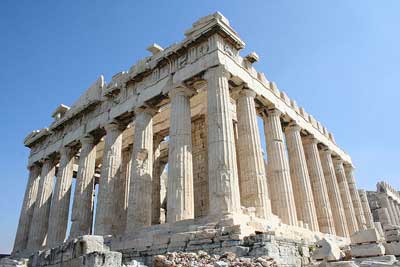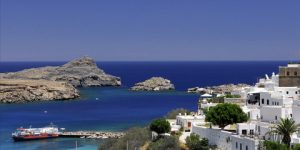Pylos
Pylos is named after Homer’s King Nestor of Pylos and is situated to the southeast of Peloponnese. This Nestors Palace is a well-preserved Mycenaean building. Though archaeology has not been able to confirm whether a man named Nestor ever lived in this palace, yet the Megaron where a king like him once resided survives to date.
While on one side of the palace are the domestic quarters, the other were rooms devoted to the administration of the palace. In one of these rooms were found dozens of tablets written in Mycenaean. The Linear B script which has been discovered points out the evidence of a sound picture of the local economy at the end of the Mycenaean Period in 1100 BC. The Queens Bathtub stands as one of the earliest examples of ancient Greek luxury.
Corinth City
Corinth was one of the more important cities of ancient Greece, more famous because of its association with the visit of St Paul during the Roman Period. A lot of the monuments we see today at Corinth like for instance the forum, the lines of shops, the multi-seated latrine, etc date back to the Roman Period.

A reminder of Corinths early history is the massively constructed Temple of Apollo, which also happens to be the first stone-built Doric-style temple in Greece. Although only a few columns remain standing as of today, is sufficient to imagine what it must have been like when complete.
The City of Sparta
The city of Sparta which was once the head of the Peloponnesian League and home to the most feared warriors in ancient Greece is almost all gone. This is quite similar to the prediction made by Thucydides as long back as 2,500 years ago that there would be little left at Sparta to remind people of its greatness which is coincidentally true. The ruins of the ancient state of Sparta reside away from the modern city of Sparta. It still houses some ancient buildings, the sanctuary of Athena Halkiotou, and another ancient theatre. A magnificent figure of the legendary ancient spartan king, Leonidas has been built here.

The sanctuary of Artemis Orthia still remains with some buildings dating back to the ancient period. The Acropolis, as of today, is an olive-tree covered hill with a few columns and walls in evidence and the major excavation which has been so carried out have been to reveal the scant remains of the Temple of Artemis Orthia in the Spartan region.
City of Phillipi
It is a coastal city in the north Greek province of Kavala. This site was built around the 4th century BC and was originally known as Krenides. This had been conquered by Philip II and made it one of the important cities in the Macedonian empire. This has even been accorded a heritage site status by UNESCO.
Theatre of Dionysus
It is the largest open-air theatre in ancient Greece and is located in Athens. Its remains are well preserved until today. It was mostly used in festivals. Worshipping of Dionysus was held here.The theatre has a central stage and 67 marble thrones around it.Even the names of dignitaries who occupied them are inscribed on these thrones. Many dramatic festivals were held here in honor of Dionysus who was the god of wine and a patron of drama.
This was the place where the ancient Greeks practiced wrestling and boxing. It was attached to a gymnasium but also had the independent existence. This monument is a rectangular structure with columns and rooms at its sides. These rooms were used for bathing, storing clothes, undressing, storage of athletic equipment, oils, etc.
Akrotiri
Santorini is a famous tourist spot due to its beautiful beaches and modern restaurants. But it was based on the remains of the settlement of Akrotiri which was a bronze settlement and a very important Minoan port town. It was destroyed by a volcanic eruption in the 17th century and is compared to the city of Pompei. Many exciting excavations have taken place in recent times yielding remains of buildings, artifacts and even frescoes.
Aigai
The ruins of the ancient Macedonian capital bear the town of Vergina in modern Greece known as Aigai. It had a burial site with almost around 300 burials with lavish decorations and it is said to be the site where the Macedonian king and the father of Philip II were buried. It is also the place where Alexander the Great was crowned as the king of Macedonia. It is a treat for lovers of Ancient Greek history.
Marathon
Marathon is situated forty kilometers northeast of Athens. This site is famous for the battle fought in 490 BC between the Greeks and the Persians. In this battle 10,000 Athenian troops with the help and support of 1000 troops from the town of Plataea, determinedly defeated the Persians. This propelled Athens into the limelight and was perhaps the most revered event in the city’s history. The tumulus is the original early fifth-century construction.

The Kerameikos describes a district on either side of the small river Eridanos, a few kilometers away from the Acropolis. As a matter of fact, by the very use of the word ceramic homage is paid to this site.
From at least the Mycenaean Period until the Classical Period it was used for two purposes as a cemetery and as a Greek Places where pottery was made (hence the word ceramic). Today kilns and grave monuments which have so survived help us visualize ancient Athenian life just outside the city wall.
There cannot be any second thoughts on the fact that there cannot be an any better way to experience and learn about a country than by actually traveling to its different regions in order to the first-hand observations and experience of its geographic settings, culture, diversity, and more importantly, its way of life.
Agora of Athens
The agora in Athens is one of the most popular tourist destinations which lies just below its Acropolis. It was the ancient marketplace of ancient Athens which had a flourishing business.
Stoa of Attalos
The Stoa of Attalos was an architectural marvel built in the Hellenistic period as a gift to Athens. It measures about 377 by 600 feet and is built of Pantelic marble and limestone.
The Doric order is used on the exterior colonnades of the ground floor while mixing it with the Ionic style on the interior. It comprises 21 rooms on each story lining up the western wall along with two corridors. The modern monument was reconstructed in the 20th century as the original had been destroyed in the 3rd century.

A place like Greece is famous for its rich history and an acclaimed association with the development of Western civilization, that any tourist will get the added advantage of being there to ponder about great Greek thinkers as well as things or events that happened in the past which has its effects on our present day life as well.
More info to- Ancient Greek landmarks, ruins, ruins Parthenon